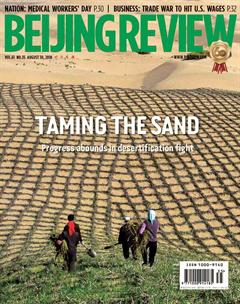Victory Or Concession?
By Lan Xinzhen
‘The U.S. is winning the trade war with China,”“Tariffs are working big time” and “really hurting their economy.” This brand of triumphant rhetoric, posted by U.S. President Donald Trump on his Twitter account, has been taken as evidence of the countrys victory in the trade war by some U.S. media outlets.
But has the United States really won? In fact, the trade war has only just begun and the two parties have thus far only touched gloves as boxers do before the fi ght truly gets underway. The fi nal winner remains to be seen.
So what about the impact of U.S. tariffs on Chinas economy? Statistics released by Chinas Ministry of Commerce show that the countrys actual utilization of foreign capital in the fi rst half of 2018 increased steadily. During that period, newly established foreign-invested enterprises across China grew by 29,591, an increase of 96.6 percent year on year. The actual utilization of foreign investment was $68.32 billion, increasing by 4.1 percent year on year.
Chinas foreign trade looks similar. On July 6, the United States started imposing tariffs on selected Chinese exports, while statistics from Chinas General Administration of Customs show that the total value of Chinese imports and exports reached 2.6 trillion yuan ($376.8 billion), with an increase of 12.5 percent in July. Chinas imports hit 1.39 trillion yuan ($201.4 billion) and increased by 6 percent, while exports reached 1.21 trillion yuan ($175.4 billion), with an increase of 20.9 percent. In view of the statistics, there is nothing to suggest that Chinas exports and imports have been adversely infl uenced by the trade war.
As for trade between China and the United States, Chinas exports to the latter reached 267.66 billion yuan($38.79 billion) with an increase of 5.6 percent, while imports from the United States stood at 87.06 billion yuan ($12.62 billion), increasing by 4.3 percent. Neither do these statistics show any sign of Trumps supposed victory.
The Trump administration has always imposed high tariffs amid trade frictions with other economies in a highway-robbery approach, before long announcing the concession of its rivals and the victory of the United States itself. He then returns to negotiations and forces rivals to accept an offer favorable to him. It seems that Trump intends to repeat this strategy in the Sino-U.S. trade war.
Chinas response is in stark contrast to the illegal action of the Trump administration, having fi led a com- plaint with the World Trade Organization to defuse the tension under the framework of international rules and winning the support of the international community.
More importantly, the trade war has not materially injured the Chinese economy and the Chinese Government is well prepared for an attritional campaign.
This is what Trump is not willing to see. Although the Chinese economy will surely be affected if bilateral economic and trade exchanges stall due to the trade war, the damage to the United States will be too much for it to bear.
In 2017, the value of trade between China and the United States reached $580 billion, accounting for nearly 15 percent of the total foreign trade of the United States. Once bilateral trade stagnates, U.S. foreign trade could be hurt as much as that of China. It should also be noted that in 2017 the United States imported $430 billion of goods from China and China bought $150 billion of U.S. products. If the trade tensions escalate, China needs to seek $150 billion of imports elsewhere to substitute those from the United States, while the United States will have to replace $430 billion of Chinese exports.
Whether the United States can fully substitute so many Chinese exports with goods from other countries still remains to be seen. Trump has probably also considered the possible reaction of the U.S. public once the trade war settles in for the long haul, especially with all exports from China covered on the U.S. tariff list.
China will not yield and is prepared for a long-lasting battle, with Trump more likely to blink fi rst in this particular standoff. In claiming that “the U.S. is winning the trade war with China,” Trump is revealing his intention to negotiate.
After sizing each other up and learning each others strengths, the two sides can hopefully now approach the negotiating table with more respect for one another.
Sure enough, upon invitation, Vice Minister of Commerce Wang Shouwen visited the United States in late August and talked with his U.S. counterpart about bilateral economic and trade issues.
It thus makes sense for Trump to portray a return to the negotiating table as the result of his victory so as to retain his pride and fi nd a way out of the unwinnable situation he has gotten himself into.

